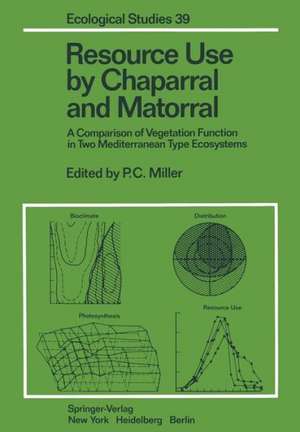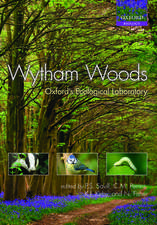Resource Use by Chaparral and Matorral: A Comparison of Vegetation Function in Two Mediterranean Type Ecosystems: Ecological Studies, cartea 39
Editat de P. C. Milleren Limba Engleză Paperback – 13 oct 2011
Din seria Ecological Studies
- 18%
 Preț: 1118.93 lei
Preț: 1118.93 lei -
 Preț: 553.72 lei
Preț: 553.72 lei - 18%
 Preț: 1680.55 lei
Preț: 1680.55 lei - 18%
 Preț: 1003.38 lei
Preț: 1003.38 lei - 20%
 Preț: 1004.71 lei
Preț: 1004.71 lei -
 Preț: 480.62 lei
Preț: 480.62 lei - 5%
 Preț: 752.26 lei
Preț: 752.26 lei - 15%
 Preț: 643.99 lei
Preț: 643.99 lei - 15%
 Preț: 644.18 lei
Preț: 644.18 lei - 15%
 Preț: 652.49 lei
Preț: 652.49 lei - 18%
 Preț: 789.83 lei
Preț: 789.83 lei -
 Preț: 382.36 lei
Preț: 382.36 lei - 15%
 Preț: 643.48 lei
Preț: 643.48 lei - 15%
 Preț: 646.30 lei
Preț: 646.30 lei - 15%
 Preț: 634.32 lei
Preț: 634.32 lei -
 Preț: 384.86 lei
Preț: 384.86 lei - 18%
 Preț: 789.98 lei
Preț: 789.98 lei - 15%
 Preț: 645.14 lei
Preț: 645.14 lei - 15%
 Preț: 649.39 lei
Preț: 649.39 lei - 18%
 Preț: 1005.43 lei
Preț: 1005.43 lei - 18%
 Preț: 949.23 lei
Preț: 949.23 lei - 15%
 Preț: 649.54 lei
Preț: 649.54 lei - 15%
 Preț: 643.34 lei
Preț: 643.34 lei - 15%
 Preț: 649.71 lei
Preț: 649.71 lei - 15%
 Preț: 638.76 lei
Preț: 638.76 lei - 18%
 Preț: 957.62 lei
Preț: 957.62 lei - 18%
 Preț: 1235.25 lei
Preț: 1235.25 lei - 18%
 Preț: 962.18 lei
Preț: 962.18 lei - 18%
 Preț: 949.23 lei
Preț: 949.23 lei - 15%
 Preț: 660.68 lei
Preț: 660.68 lei -
 Preț: 397.76 lei
Preț: 397.76 lei - 15%
 Preț: 638.24 lei
Preț: 638.24 lei - 18%
 Preț: 942.31 lei
Preț: 942.31 lei - 18%
 Preț: 1232.57 lei
Preț: 1232.57 lei - 15%
 Preț: 651.34 lei
Preț: 651.34 lei - 18%
 Preț: 952.72 lei
Preț: 952.72 lei - 18%
 Preț: 1834.27 lei
Preț: 1834.27 lei - 18%
 Preț: 1229.10 lei
Preț: 1229.10 lei -
 Preț: 423.95 lei
Preț: 423.95 lei - 18%
 Preț: 948.92 lei
Preț: 948.92 lei
Preț: 402.56 lei
Nou
Puncte Express: 604
Preț estimativ în valută:
77.03€ • 83.94$ • 64.91£
77.03€ • 83.94$ • 64.91£
Carte tipărită la comandă
Livrare economică 23 aprilie-07 mai
Preluare comenzi: 021 569.72.76
Specificații
ISBN-13: 9781461258988
ISBN-10: 1461258987
Pagini: 480
Ilustrații: 455 p.
Dimensiuni: 170 x 244 x 25 mm
Greutate: 0.76 kg
Ediția:Softcover reprint of the original 1st ed. 1981
Editura: Springer
Colecția Springer
Seria Ecological Studies
Locul publicării:New York, NY, United States
ISBN-10: 1461258987
Pagini: 480
Ilustrații: 455 p.
Dimensiuni: 170 x 244 x 25 mm
Greutate: 0.76 kg
Ediția:Softcover reprint of the original 1st ed. 1981
Editura: Springer
Colecția Springer
Seria Ecological Studies
Locul publicării:New York, NY, United States
Public țintă
ResearchCuprins
1. Conceptual Basis and Organization of Research.- 1.1. General Background.- 1.2. Objective of Research.- 1.3. Methodology.- 1.4. Conclusions and Discussion Regarding Hypotheses.- 2. Resource Availability and Environmental Characteristics of Mediterranean Type Ecosystems.- 2.1. Introduction.- 2.2. General Description of Regions.- 2.3. Wind, Temperature, and Atmospheric Humidity.- 2.4. Seasonal Patterns of Water Availability.- 2.5. Seasonal Patterns of Solar Irradiance.- 2.6. Environmental Influences on the Length of the Growing Season and Summer Drought.- 2.7. Hypothetical Plant Responses.- 2.8. Conclusions.- 3. The Plant Communities and Their Environments.- 3.1. Introduction.- 3.2. Species Abundance and Phyletic Similarity.- 3.3. Vegetation Communities in Southern California and Central Chile.- 3.4. Distribution of Species Along Gradients of Aspect, Elevation, and Moisture.- 3.5. Distribution of Growth Forms Along Gradients of Aspect, Elevation, and Moisture.- 3.6. Structural Similarity of Vegetation in Southern California and Central Chile.- 3.7. Conclusions.- 4. Biomass, Phenology, and Growth.- 4.1. Introduction.- 4.2. Biomass.- 4.3. Seasonal Biomass Dynamics.- 4.4. Annual Biomass Budget of Chaparral Shrubs.- 4.5. Conclusions.- 5. Microclimate and Energy Exchange.- 5.1. Introduction.- 5.2. Topographic Influence on Microclimates.- 5.3. The Partitioning of Solar Irradiance by the Canopy and Soil.- 5.4. The Partitioning of Absorbed Solar Irradiance in the Canopy.- 5.5. Conduction.- 5.6. Energy Budgets for Coastal and Montane Sites.- 5.7. Effect of Vegetation Form on Microclimate, Plant Temperature, and Energy Exchange Processes.- 5.8. Conclusions.- 6. Water Utilization.- 6.1. Introduction.- 6.2. Hydrologic Balance.- 6.3. Control of Species Water Relations.- 6.4. Diurnaland Seasonal Patterns of Plant Water Relations.- 6.5. Environment and Plant Influences on Water Capture Efficiency.- 6.6. Conclusions.- 7. Energy and Carbon Acquisition.- 7.1. Introduction.- 7.2. Patterns of Temperature and Light Dependency.- 7.3. Simulated Temperature Sensitivity.- 7.4. Simulated Fit of the Photosynthetic Temperature Optima.- 7.5. Quantum Efficiency at Light Saturation.- 7.6. Growth Form Effects on Photosynthetic Rate.- 7.7. Relation Between Photosynthetic Competence and Cover.- 7.8. Seasonal Patterns of Carbon Uptake.- 7.9. Conclusions.- 8. Carbon Allocation and Utilization.- 8.1. Introduction.- 8.2. Carbon Losses Through Respiration.- 8.3. Carbon-14 Dioxide Utilization.- 8.4. Root Turnover.- 8.5. Annual Carbon Budgets.- 8.6. Simulated Temperature Sensitivity of Carbon Metabolism.- 8.7. Organic Nutrient Levels.- 8.8. Conclusions.- 9. Mineral Nutrient and Nonstructural Carbon Utilization.- 9.1. Introduction.- 9.2. Seasonal Patterns of Plant Nutrient Content.- 9.3. Influences of Nutrients on Plant Growth.- 9.4. Conclusions.- 10. Nutrient Cycling in Mediterranean Type Ecosystems.- 10.1. Introduction.- 10.2. Intersystem Cycles.- 10.3. Nutrient Pools.- 10.4. Intrasystem Cycles.- 10.5. Conclusions Regarding Nutrient Dynamics During Ecosystem Development.- 11. Models of Plant and Soil Processes.- 11.1. Introduction.- 11.2. Canopy Process Simulator.- 11.3. The Mediterranean Ecosystem Simulator.- 11.4. Validation.- 11.5. Conclusions.- 12. Similarities and Limitations of Resource Utilization in Mediterranean Type Ecosystems.- 12.1. Introduction.- 12.2. Similarities of Resource Use and Resource-Use Efficiency.- 12.3. Environmental Limitations of Resource Use and Resource Use Efficiency.- 12.4. Functional Interpretation of Morphological and Physiological Characteristics of Mediterranean Shrub Vegetation.- 12.5. Relative Importance of Plant Adaptations Versus Environment in Affecting Resource Use and Resource-Use Efficiency.- 12.6. Conclusions.- Literature Cited.- Resumen / Gloria Montenegro.











